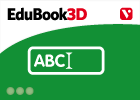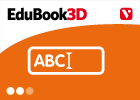Cargando...
Recursos educativos
-
Nivel educativo
-
Competencias
-
Tipología
-
Idioma
-
Tipo de medio
-
Tipo de actividad
-
Destinatarios
-
Tipo de audiencia
-
Creador
Lo más buscado
- Actividades cuerpo humano primaria
- Regiones de Francia
- Rios de Asia
- Generador de anagramas
- Aprender a comer
- Descargar ejercicios de ingles
- Caillou
- exámenes selectividad
- Residuos sólidos urbanos
- Ejercicios latín
- Repaso de francés
- Nacionalismo y liberismo
- El Lazarillo de Tormes
- Palabras agudas, llanas y esdrújulas
- Música rock
-

Initial evaluation 01 - Animal reproduction
EduBook Organización
- 2482 visitas
Classify the following animals as oviparous or viviparous: snail ➝ deer ➝ duck ➝ chicken ➝ cheetah ➝ wolf ➝
-

Initial evaluation 01 - Plant reproduction
EduBook Organización
- 2439 visitas
Decide if the following statements are true (T) or false (F): The fruit contains the seed. ➝ The fruit can be edible or not. ➝ All edible fruits are fleshy. ➝ Seeds germinate as soon as they fall…
-

Initial evaluation 04 - Animal reproduction
EduBook Organización
- 2421 visitas
Complete the sentences with the correct words: In most animals there is a male and a . Animals which are born from a mother are called . Animals which are hatched from an egg are called . To become…
-

Final evaluation 03 - Human reproduction
EduBook Organización
- 2380 visitas
List the main organs of the female reproductive system. Where does the union of sperm and ovum take place?
-

Initial evaluation 03 - Animal reproduction
EduBook Organización
- 2293 visitas
Choose the correct answer in each case: The type of reproduction which only requires one individual: The male reproductive system makes... Animals that hatch from eggs are called... Which of these…
-

Final Autoevaluation 4.04 - Animal reproduction
EduBook Organización
- 2216 visitas
The following table shows how the weight of a litter of mice progresses after birth: How many days did the mice take to double their weight after birth? days. Calculate on approximately which day the…
-

Check. Reproduction in living things
EduBook Organización
- 2206 visitas
Remember what you have studied in this section and answer the questions: What is the purpose of reproduction? Explain the basic types of reproduction. What are the different stages in sexual…
-

Initial evaluation 01 - Human reproduction
EduBook Organización
- 2167 visitas
Mark each sentence as true or false: The sex cell of men is called an ovum. ➝ Testicles produce sperm. ➝ Fertilisation is the formation of an ovum or a sperm. ➝ Women are female. ➝
-

Learn. Spontaneous generation - Animal reproduction
EduBook Organización
- 2168 visitas
In ancient times, many people believed that living things could be created spontaneously from decomposing material. Aristotle stated that flies and mosquitoes were produced spontaneously from mud in…
-

Look and answer. Asexual reproduction
EduBook Organización
- 2147 visitas
Look at the photo of the lizard. Why is the regrowing of its tail not considered asexual reproduction? What advantages do you think asexual reproduction has?
Te estamos redirigiendo a la ficha del libro...













